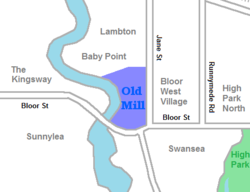Old Mill, Toronto
| Old Mill | |
|---|---|
| Neighbourhood | |

|
|
 |
|
| Country |
|
| Province |
|
| City |
|
| Government | |
| • MP | Arif Virani (Parkdale—High Park) |
| • MPP | Cheri DiNovo (Parkdale—High Park) |
| • Councillor | Sarah Doucette (Ward 13 Parkdale—High Park) |
Old Mill is a neighbourhood of Toronto, Ontario, Canada on the banks of the Humber River. It is located north and west of the intersection of Bloor Street and Jane Street. The area takes its name from the old grist mill ruins on the west bank of the river, now converted into a hotel (also named "Old Mill"). The City of Toronto includes this neighbourhood in the official "Lambton Baby Point" neighbourhood which includes the Baby Point enclave and former Lambton village areas to the north.
The neighbourhood's houses are primarily single-family detached homes, built before and after the Second World War. The Old Mill Inn & Spa is located in the neighbourhood on the west side of the Humber River in Etobicoke. Most of the area is on a slope leading down from Jane and Bloor Streets, into the Humber valley. One street, Halford Avenue, is paved with brick, cobblestones or paving stones. Several of the more steep streets can become impassable in the wintertime.
Along Bloor Street, two condominium developments replaced an auto dealer. Some businesses exist on the north side of Bloor Street and the west side of Jane around the intersection. There is a film theatre, the Humber Cinema multiplex at the intersection of Bloor and Jane.
Historically, it was a hunting and fishing area for First Nations. A native village existed just to the north at Baby Point before European colonisation. By 1720, the French had established a small fortified settlement called Magasin Royal, near the present site of the Old Mill, for trading with native bands. By 1800, the first English settlement in the area was around the Kings Mill, used to cut lumber for the first homes in York, Upper Canada, now known as Toronto. A series of mills were constructed, until the last one was abandoned in 1881.
After 1900, the area was laid out for residential uses. The Old Mill Tea Room was used as a community centre as the area was developed. The neighbourhood was part of York Township. The extreme south edge of the land was part of Swansea, and lands along Jane Street were a part of Toronto. York became the Borough of York, then the City of York and was finally merged into the amalgamated City of Toronto in 1998.
...
Wikipedia
